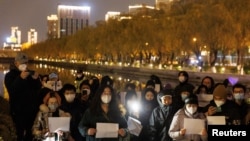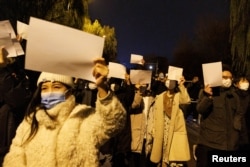Protests that erupted across China against stringent COVID-19 lockdown measures are the most widespread demonstrations there since days of the 1989 Tiananmen Square occupation.
The catalyst for the new protests was a deadly fire at a residential apartment block in Urumqi, the capital of China’s northwestern Xinjiang region, home to ethnic Uyghurs who have been targets of Chinese government repression.
At least 10 people died in the blaze, and pandemic restrictions reportedly blocked residents of the apartment block from fleeing and prevented firefighters from reaching the scene.
Some demonstrators made broader statements of political discontent, with protesters in Shanghai chanting “Xi Jinping! Step down! CCP! Step down!” in reference to President Xi Jinping and the ruling Chinese Communist Party.
On November 28, Beijing vaguely claimed that “forces with ulterior motives” were behind the protests, saying local authorities had refuted “this information and smears” that the fire was linked to COVID-19 restrictions.
Russia’s privately owned Pravda.ru online news portal took the accusations further and blamed the United States, with columnist Lyubov Stepushova writing:
“The protests have all the hallmarks of a ‘color revolution,’ … Such coup attempts are always initiated by local political elites with the support of the United States.”
That is false. Stepushova presented no direct evidence that the United States instigated the protests. The White House, however, has questioned China's "zero-COVID" strategy while backing the right of Chinese citizens to speak out.
Various popular protest movements worldwide have adopted a specific color as their symbol – for example, Ukraine's 2004 Orange revolution. That is why the Kremlin and others use the label “color revolution” as shorthand.
In Iran, state media have used the term “color revolution” to discredit the protests that erupted across that country following the death in September of 22-year-old Mahsa Amini, who’d been arrested by the country’s morality police for improperly wearing a head covering, or hijab.
In her op-ed, Pravda.ru’s Stepushova wrote that the use of blank sheets of white paper by Chinese demonstrators is a “sign” the protests are a color revolution. She noted that participants in the 2019-2020 Hong Kong pro-democracy protests used the same symbol.
“[T]hose protests were called a ‘color revolution’ by Chinese authorities, as they were coordinated by the head of the political department of the U.S. Consulate General in Hong Kong,” Stepushova wrote, also claiming that “‘anti-war’ demonstrators in Moscow have also used white sheets this year.”
In fact, protesters in Hong Kong and Russia used blank sheets of paper for the same reason – to symbolize the draconian curbs on free speech that criminalized peaceful expression of political opinion.
In Russia, individuals can be sentenced up to 15 years in prison for spreading “false news” about Russia’s armed forces. That includes calling Russia’s war in Ukraine a war or invasion.
Hong Kong’s National Security Law allows the government to criminalize free speech and journalistic activity under the pretext of national security. Vaguely defined “acts of subversion” can result in life imprisonment.
Demonstrators in Russia and Hong Kong have been arrested for holding up blank placards, further underlining the lack of free expression and assembly.
Likely inspired by compatriots in Hong Kong, university students protesting in Chinese cities including Nanjing and Beijing have held up blank sheets of paper, “a tactic used in part to evade censorship or arrest,” Reuters reported.
“The white paper represent everything we want to say but cannot say,” a 26-year-old protester in Beijing told Reuters.
CNN’s Laura He described the white sheets of paper as “a metaphor for the critical social media posts, news articles, and outspoken online accounts that have been wiped from the internet as thousands of people took to the streets.”
The phrase “white paper” has been censored on Chinese social media.
Hong Kong protesters have in turn staged blank placard protests to show solidarity with protesters in mainland China.
Protesters in Beijing have mocked the idea they are being directed by outside forces. One of them asked whether foreign forces started the fire in Xinjiang or overturned a bus heading to a quarantine facility in China’s southwestern Guizhou province in September, killing 27 and injuring 20 others.
That protester noted that Chinese citizens cannot access the outside internet due to censorship by the government’s Great Firewall, rhetorically asking: “How are foreign forces meant to be communicating with us?”
Stepushova’s unsubstantiated claim that the U.S. Consulate General in Hong Kong “coordinated the protests” may refer to the fact that a U.S. diplomat met with members of the city’s pro-democracy movement in August 2019.
Beijing then leaked that diplomat’s personal information, prompting a harsh official U.S. rebuke.
“Foreign diplomats in the United States, including Chinese ones, enjoy open access to all elements of American politics, civil society, academia, and business,” U.S. State Department spokesman Ned Price said at the time.
The pro-democracy protests in Hong Kong clearly had broad-based support, with an August 2019 demonstration drawing an estimated 1.7 million people – a quarter of Hong Kong’s population – despite a police order to stay home.
Stepushova also claimed the United States was attempting “to accelerate the coup” in China after Taiwan’s ruling, pro-independence Democratic Progressive Party (DPP) suffered local election losses earlier this month.
Taiwan analysts, however, have cautioned against giving international weight to a local election that was not focused on national security.
“Local elections in Taiwan are primarily driven by individual candidates, local patronage networks and community issues. This is in stark contrast to presidential and national elections, when China-Taiwan relations and national security feature prominently,” Japan’s Nikkei Asia reported after the vote.
China regards Taiwan as a breakaway province. In Taiwan, public support for reunification remains low.






